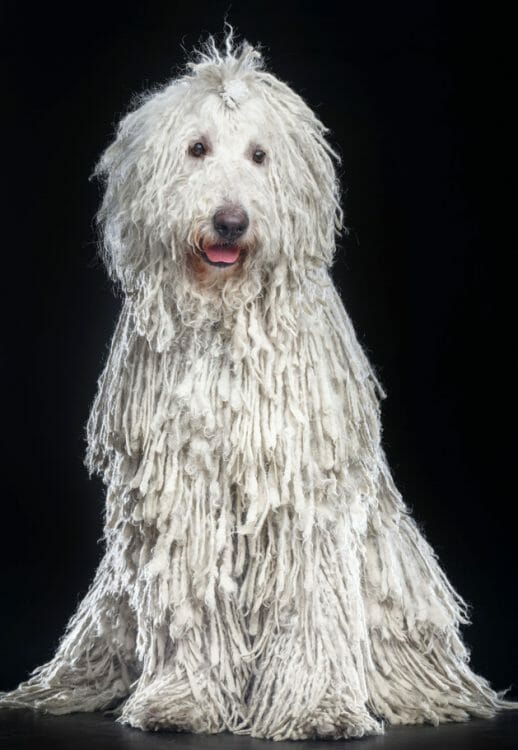Komondor Dog

What Is a Komondor Dog?
Also called a Hungarian sheepdog or “mop dog,” the Komondor dog is a distinctly recognizable livestock guardian with a long white corded coat that resembles dreadlocks. Regarded as a national treasure in its native Hungary, the breed is long-established. The breed’s distrust of strangers and territorial nature means they make excellent guard dogs. Despite its long heritage, this is a rare breed with less than 10,000 in existence throughout the entire world.

What Does a Komondor Dog Look Like?
Averaging around 25 inches at the shoulder for a female and 27 inches for a male, the Komondor mop dog can weigh anywhere from 80 to 120 pounds. Much of the dog’s facial features are covered with its tasseled hair. It has a medium-sized head.
The breed’s trademark “mop” coat was developed to keep the dog warm in the harsh Hungarian winters and to provide protection from predators. Being completely white, the dog’s coat allows it to blend in with the flocks of sheep it tends.
While the Komondor is still a puppy, it will have a fluffy coat that will start to mat from the age of eight months of age.

Komondor Dog Facts
- The name Komondor translates to “Cuman dog.” The breed is believed to have descended from Tibetan canines found by the Cumans.
- As the Mongols began conquering new territories in the 10th century, the Cumans were forced to seek asylum further west. Eventually, in the 12th and 13th centuries, the nomadic Turkic-speaking Cumans brought the Komondor to Hungary.
- The dogs brought by the Cumans were like a native Hungarian sheepdog, which was later interbred with the Komondor.
- The first mention of the Komondor is in the History of King Astiagis, a Hungarian book written in 1544. Later, Amos Comenius talks about the dogs in a book published in 1673.
- Although common in Hungary to this day, many Komondors were slaughtered by invading German and Russian soldiers during World War II. This was because whenever armies would capture farms and houses, they would first kill the dog guarding it.
- Although the breed was officially recognized by the American Kennel Club in 1937, Komondors were rarely found outside of Hungary until the 1960s.
Dog Breeds With Shared Heritage
 The dog shares a common heritage with the following canine breeds.
The dog shares a common heritage with the following canine breeds.
- Pulis
- South Russian Ovcharkas
- Mudis
- Pumis
- Schapendoes
- Bearded Collies
- Polish Lowland Sheepdogs
- Old English Sheepdogs
- Pyrenean Sheepdog
- Portuguese Sheepdogs
- Catalan Sheepdogs
- Bergamasco Shepherds
Komondor Dog Temperament
Because the breed evolved primarily to protect flocks of sheep, the Komondor is fiercely territorial and has a strong wariness of strangers. When kept as a household pet, Komondors act as dutiful guards and devoted companion dogs.
Historically, the Komondor was bred to live in open fields where it would independently make decisions on how best to protect the flock. This independent instinct remains strong within the breed’s characteristics. making it too self-sufficient for many households.
Anyone considering owning a Komondor should be prepared to be firm and use positive reinforcement training with their animal. This will help maintain a good relationship between owner and dog and set clear expectations and boundaries.
Regardless of its independence, the Komondor can make a wonderful family pet that ensures its owners are always within sight at any given time. This means that the Komondor will follow family members around the home. These dogs are typically good with other animals and young children.
The highly alert Komondor is known to bark loudly. This is something that owners with close neighbors need to consider. Although this type of dog is a fast runner, adult Komondors generally require very little exercise. That said, the dog will need to be walked daily. As the breed has developed to be a static guardian, large yards are not needed.

How Do You Groom a Komondor Dog?
Komondor dog grooming is essential, and coat care can be a challenge. It is natural for the coat to become corded and matted when the dog becomes an adult. As the Komondor puppy reaches maturity, owners will need to tear any larger mats apart to prevent tight cords from forming.
Once the cords have formed in the coat, they will lengthen as the dog ages and can reach the ground if they are not trimmed.
The undercoat will be shed twice a year. When this occurs, owners should separate the coat by hand to prevent mats from developing close to the skin. This task can take a few hours.
Weekly maintenance should be carried out to keep cords looking neat. In addition, hair should be regularly plucked from the ear canal.
Because the floor-length cords can become dirty, many owners will limit the coat to approximately 10 inches in length. To prevent the tassels from becoming dirty, the dog should be bathed regularly. However, washing and drying a Komondor can take a long time.
Despite the intensive grooming required, Komondors are considered a hypoallergenic dog breed.

Komondor Health
There are no specific health problems that Komondors are predisposed to. Any responsible breeders will have their animals certified as being free of hip dysplasia by the Orthopedic Foundation for Animals. That said, hip dysplasia is a condition that affects many larger breeds (such as the Cane Corso and the Newfoundland), the Komondor should be monitored for symptoms such as limping or lameness from a young age.
Breeders are also asked for eye health certifications by the Komondor Club of America to minimize any hereditary problems. Common eye problems could include entropion, a condition that causes the eyelid to turn inward and scratch the surface of the cornea.
One problem that owners should be aware of is the potential for developing bloat. Bloat is a life-threatening condition where the dog’s stomach becomes twisted. Also known as gastric torsion, this condition can come on suddenly, and owners need to act and seek veterinary assistance immediately.
Komondor Life Expectancy
A healthy Komondor can be expected to live for between 10 and 12 years. Good health can be ensured by:



